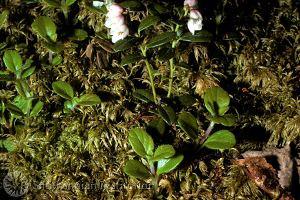The berries of
Vaccinium vitis-idaea are eaten raw or cooked and are used to make jams, jellies, candy, beverages, sauces, and wine. Native Americans used the leaves and berries of lingonberry medicinally and as food. The leaves, stems, and berries are used to make yellow and purple dye.
Vaccinium vitis-idaea is native to the U.S. and is in the Ericaceae (Heath Family).
Photo Credit: © 2008 Ted Niehaus. Courtesy of life.nbii.gov.
Vaccinium vitis-idaea
Common Name: lingonberry
Plant Functional Group: Evergreen broadleaf
Class > Order > Family: Magnoliopsida > Ericales > Ericaceae
What does the species look like?
Vaccinium vitis-idaea is an evergreen, perennial, low shrub that can grow to be 1 to 3 feet in height. It grows from a rhizomatous root system and has a short life span. The stems are low growing, trailing, and slender and sometimes form mats. The foliage of lingonberry is oval, shiny, leathery, and green and turns purple in the fall. The flowers are white to pink, bell-shaped, and in clusters. The fruit is a red berry, and the seeds are yellow. Lingonberry can grow in mountain meadows, pine woods, rocky areas, moist forests, open slopes, and bogs. It can tolerate shade to full sun at higher elevations. It prefers wet to moist, well-drained rocky soils.
Vaccinium vitis-idaea is pollinated by bees. Many species of mammals eat the leaves and berries of
Vaccinium vitis-idaea including caribou, black bear, moose, hare, and reindeer. The berries of
Vaccinium vitis-idaea is an important food source for many species of migratory birds heading north in spring
. Small mammals such as squirrels, fox, skunk, chipmunks and vole also eat the berries of lingonberry. Some small mammals and birds use the shrub for cover. Bees and butterflies also are attracted to lingonberry.
Where is the species found?
States & Provinces
AB, AK, BC, CT, MA, MB, ME, MI, MN, NB, NH, NL, NS, NT, NU, ON, PE, QC, SK, VT, WI, YT
Special Considerations for Observing
1. If drought seems to be the cause of leaf color or fall for a plant, please make a comment about it for that observation.
Which phenophases should I observe?
Do you see...?
Leaves
Breaking leaf buds More...
How many buds are breaking?
Less than 3 3 to 10 11 to 100 101 to 1,000 1,001 to 10,000 More than 10,000
Young leaves How many young leaves are present?
Less than 3 3 to 10 11 to 100 101 to 1,000 1,001 to 10,000 More than 10,000
Flowers
Flowers or flower buds More...
How many flowers and flower buds are present? For species in which individual flowers are clustered in flower heads, spikes or catkins (inflorescences), simply estimate the number of flower heads, spikes or catkins and not the number of individual flowers.
Less than 3 3 to 10 11 to 100 101 to 1,000 1,001 to 10,000 More than 10,000
Open flowers More...
What percentage of all fresh flowers (buds plus unopened plus open) on the plant are open? For species in which individual flowers are clustered in flower heads, spikes or catkins (inflorescences), estimate the percentage of all individual flowers that are open.
Less than 5% 5-24% 25-49% 50-74% 75-94% 95% or more
Fruits
Fruits Vaccinium vitis-idaea , the fruit is a berry that changes from green to bright red or dark red.More...
How many fruits are present?
Less than 3 3 to 10 11 to 100 101 to 1,000 1,001 to 10,000 More than 10,000
Ripe fruits Vaccinium vitis-idaea , a fruit is considered ripe when it has turned bright red or dark red.More...
What percentage of all fruits (unripe plus ripe) on the plant are ripe?
Less than 5% 5-24% 25-49% 50-74% 75-94% 95% or more
Recent fruit or seed drop More...
How many mature fruits have dropped seeds or have completely dropped or been removed from the plant since your last visit?
Less than 3 3 to 10 11 to 100 101 to 1,000 1,001 to 10,000 More than 10,000
What do these phenophases look like?
There is currently no photoguide available for this species. If you'd like help us create one, use the guidance document and species template provided here . Then send it via email to education@usanpn.org when it is complete.
